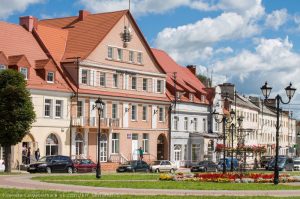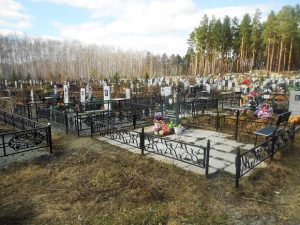You might be forgiven for thinking that you’d just stumbled on a quiet town in suburban America. Tree-lined streets peppered with skateboarding kids, cool crystal lakes and large open parks make this town just as attractive and middle class as anywhere in a brochure for a holiday village. Only a shrewd eye could notice the Geiger counters checking fruit and vegetables sold on the side of roads.
 The people who live here are immensely protective of their community, characterizing it as a place where the “intellectuals live”; with its great schools and quiet, pleasant atmosphere, this doesn’t initially invite question. But despite its grandeur, Ozersk was—and remains—devoid of visitors. In fact, until recently, this city of 100,000 people wasn’t featured on any maps at all. Even the residents didn’t exist, according to Soviet censuses of the time.
The people who live here are immensely protective of their community, characterizing it as a place where the “intellectuals live”; with its great schools and quiet, pleasant atmosphere, this doesn’t initially invite question. But despite its grandeur, Ozersk was—and remains—devoid of visitors. In fact, until recently, this city of 100,000 people wasn’t featured on any maps at all. Even the residents didn’t exist, according to Soviet censuses of the time.
For the first eight years of the town’s existence, even family members of residents weren’t allowed to enter, and residents were forbidden from leaving the city. Even writing letters or making any contact with family was strictly forbidden. Those who had been relocated here were considered missing by their relatives. It was as if they had disappeared into a black hole.
Today, there is still very little known about what happens inside Ozersk and the nearby Mayak plant, although the gravestones of many young residents in Ozersk’s cemetery bear witness to the secret the Soviets tried to bury.
Some information as to the levels of radiation can be found in villages on the outskirts of town, where digital clocks in the town centre switch between the local time and the current level of radiation in the air.
Over half a century ago, Ozersk — or City 40, as it’s codenamed — was the birthplace of the Soviet nuclear weapons programme after the Second World War, where the first Soviet plutonium-based bomb, known as “First Lightning,” was made. It was modelled after Richland, Washington where the United States had built “Fat Man,” the plutonium bomb dropped on Nagasaki at the end of World War II.
In 1946, just a year after “Fat Man” was dropped, the Soviets commenced the secret construction of City 40, around the huge Mayak nuclear plant deep in the vast forests of Russia’s Ural Mountains. The city would be comprised of workers hired from across the USSR to lead the Soviet Union’s nuclear weapons programme.
As you would imagine would be the case for those exposed to extremely dangerous nuclear radiation, people soon started to show symptoms of radiation exposure and many died or became very sick, although it is almost impossible to verify the numbers due to the authorities’ extreme secrecy and frequent denials.
The Mayak plant’s management has also overseen the dumping of its waste into nearby lakes and rivers, which ends up flowing into the Arctic Ocean. Over four decades, Mayak is said to have dumped the equivalent of four Chernobyls into the surrounding environment, although the authorities have vehemently denied this. According to some Ozersk residents, the dumping continues today. Indeed, half a million people in Ozersk and its surrounding area are said to have been exposed to five times as much radiation as those living in the areas of Ukraine affected by the Chernobyl nuclear accident.
The world is now acutely aware of the generation-haunting effects of nuclear radiation, and Ozersk is no different. The city’s residents have now learnt the truth: that their water is contaminated, their food is poisoned, and their children and children’s children may be very ill.
Between its floral pastures and peaceful serenity, Ozersk is referred to by some as the “graveyard of the Earth”, with the level of radiation in nearby lakes said to be 2.5 times that of Chernobyl.
 Yet the majority of residents still don’t want to leave. Quite the opposite; they have been led to believe by the state that they are Russia’s “chosen ones”, and even take pride in being citizens of a closed city. Many of the residents have been there since the town was created over six decades ago. Many of them have buried fathers, mothers, and often children in its pristine cemeteries. Others just enjoy the exclusivity of living in a town closed to the outside world – when they have everything that they need within its razor wire perimeter.
Yet the majority of residents still don’t want to leave. Quite the opposite; they have been led to believe by the state that they are Russia’s “chosen ones”, and even take pride in being citizens of a closed city. Many of the residents have been there since the town was created over six decades ago. Many of them have buried fathers, mothers, and often children in its pristine cemeteries. Others just enjoy the exclusivity of living in a town closed to the outside world – when they have everything that they need within its razor wire perimeter.
The inhabitants of City 40 were given a pretty sweet deal in return for their role as “nuclear shield and saviours of the world”. While the majority of the Soviet population in the 1940s was living in abject poverty, residents of Ozersk lived in shiny private apartments, with exotic food such as bananas and condensed milk. They had good schools, beautiful libraries and even evening entertainment, all offered in a beautiful lakeside setting.
Samira Goetschel, director of 2016 documentary City 40, tells Vice;
“In order for these people to remain—they weren’t going to escape anyway—but just to make sure that they are happy to be there, [the government] created a paradise for them. So they had everything they possibly needed and more in comparison to the outside world where they had absolutely nothing. And they were not placed on any map; they were a state within a state. Their identities were erased. They did not exist outside of the city. And to me it was basically like I’d entered an episode of the Twilight Zone. It’s as if these people were not living in this dimension”.
Russia has 42 known closed cities in total (there are many more internationally). They are called “ZATO” (closed administrative territorial entities) and the entry of these secret areas is strictly forbidden to foreigners. They are usually hidden in remote areas, and are sometimes indicated obliquely as a nearby insignificant village, so as not to attract attention from accidental bypasses. The actual zones can be miles away from their official namesakes; for instance, Arzamas-16, also known as Sarov, is 75 kilometres from actual Arzamas.
In the eyes of some residents of Ozersk, the secrecy surrounding the location of their town doesn’t serve to keep them separate from the rest of the world, but to keep outsiders out of their paradise. Many have stayed so long despite knowing full well about the dangers, simply because the barbed wire has become an essential part of the collective identity of the town.
According to City 40, many of the residents are perfectly happy and content to be left alone in their private, manicured graveyard.
We may not go to City 40, but we have plenty of other tours to the former Eastern Bloc!





